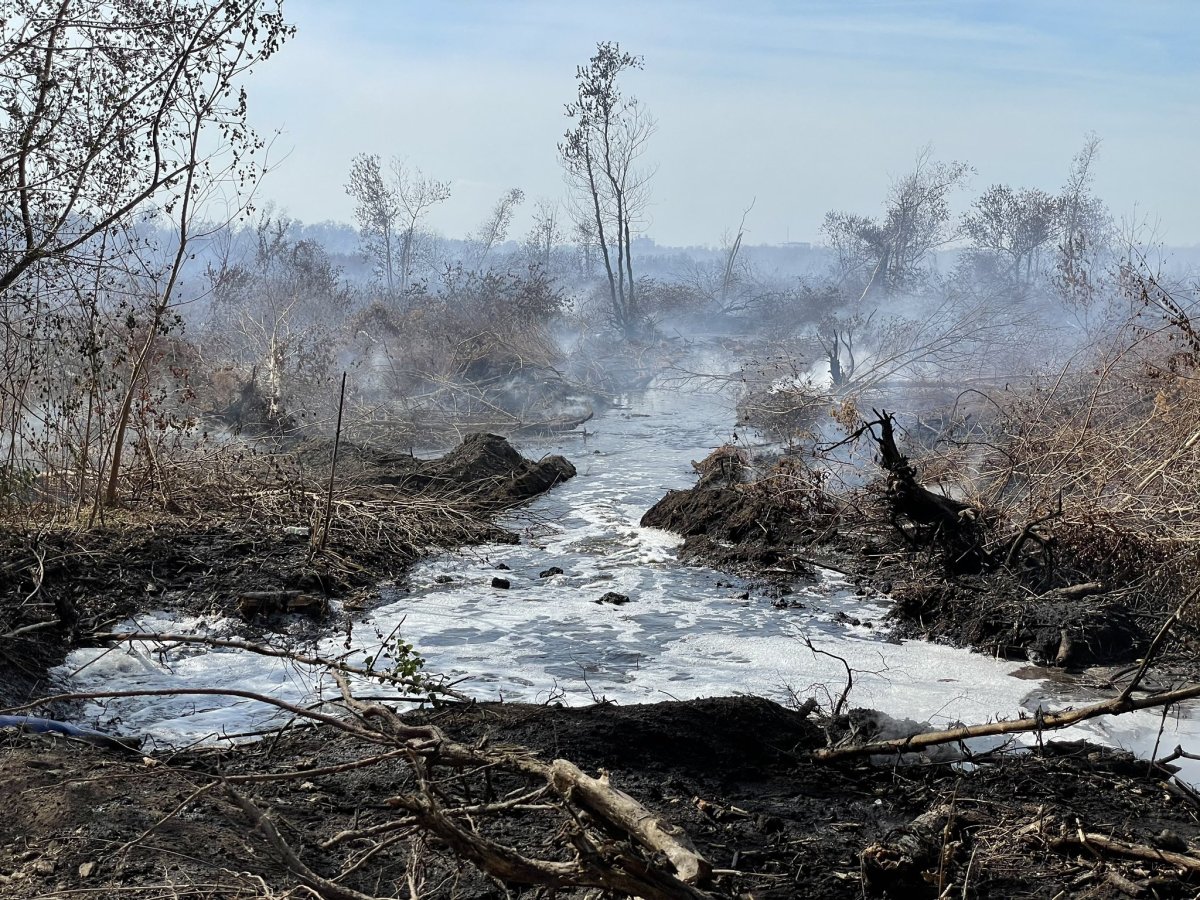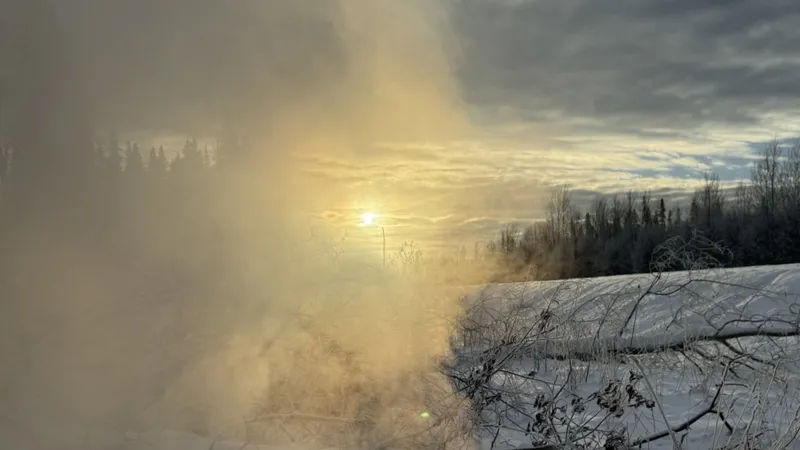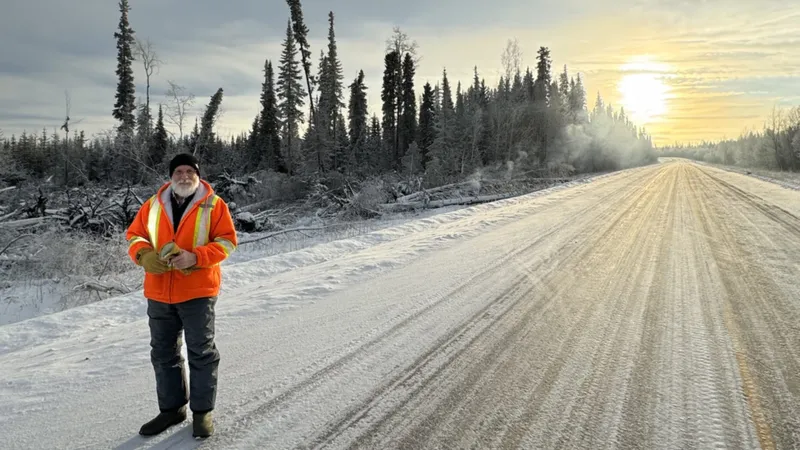Science
‘Zombie Fires’ Burning At An Alarming Rate In Canada

Even in the depths of Canada’s winter, the embers of last year’s record-breaking wildfire season persist. So-called zombie fires are burning at an unprecedented rate beneath thick layers of snow, increasing concerns about what the upcoming summer will bring.
In winter, people driving on the highway through Fort Nelson, British Columbia (BC), can see and smell the clouds of white smoke rising from the land around them.
Sonja Leverkus, a firefighter and scientist from the small north-eastern British Columbia hamlet, remembers travelling during a snowstorm in November, but the snow didn’t seem white.
‘Zombie Fires’ Burning At An Alarming Rate In Canada
Instead, she described it as blueish-grey due to the smoke in the air.
“I’ve never experienced a snowstorm that smelled like smoke,” said Ms. Leverkus, who has lived in northern British Columbia for over 15 years.
She said these plumes remained visible into February, even on extremely cold days when temperatures dropped to -40C (-40F).
‘Zombie Fires’ sparks record. Arctic carbon emissions
Zombie fires cause the Fort Nelson smoke, sometimes known as overwintering fires.
They are flameless smoulders that burn slowly beneath the surface and are kept alive by an organic soil known as peat moss found in North America’s boreal forests and heavy layers of snow that protect them from the cold.
These flames are not uncommon. Experts estimate that during the last ten years, British Columbia has witnessed an average of five or six that continue to burn over the cold months.
However, in January, the province experienced a historic peak of 106 active zombie fires, raising concerns among fire experts about the implications for the following wildfire season.
Most go out on their own before spring, but 91 are still burning in British Columbia, according to government data, and those that have not been extinguished by March may re-ignite as the snow melts and they are exposed to air.
As a result, scientists have linked them to the early onset of wildfire seasons.
The nearby province of Alberta is also experiencing an increase in these winter fires, with 57 burning as of early February, roughly ten times the five-year normal.
Jennifer Baltzer, a biology professor at Wilfrid Laurier University and the Canada Research Chair in Forests and Global Change, said, “This continued smouldering through the winter, I think, is very alarming to see,” especially after last year’s record-breaking wildfire season.
Wildfires in Canada burned about 18 million hectares (44 million acres) of land in 2023, an area roughly the size of Cambodia, greatly exceeding the country’s 10-year average.
The season was one of the worst in recent history, with several firemen killed in the line of duty.
Thousands of people were displaced from their homes, and the impact extended far beyond Canada’s borders when smoke blanketed most of the United States in June.
According to Mike Flannigan, a professor and fire control expert at Thompson Rivers University in Kamloops, BC, the devastating wildfire season is one of the reasons for the current high number of zombie fires.
The majority of them are fires that could not be completely extinguished by last autumn due to a shortage of resources, he explained.
‘Zombie Fires’ Burning At An Alarming Rate In Canada
By the end of the year, officials had recorded more than 2,200 wildfires in British Columbia.
Prof Flannigan also cited the province’s catastrophic drought over the last two years.
According to the province’s drought map, the majority of British Columbia was experiencing moderate to severe drought as of February.
According to Ms Leverkus, the dryness has been as noticeable as the zombie fires.
She noted in the forest last summer that a brook that used to run freely had become “just puddles”.
These drought conditions persisted throughout the winter. The province has received so little snow that one ski resort in BC’s South Cariboo region was forced to close for the rest of the season in early January.
Zombie fires were historically rare, but scientists claim they have become increasingly common in recent years due to a fast-warming environment.
According to Forrest Tower, a fire information officer with BC Fire, officials are now watching them.
‘Zombie Fires’ Burning At An Alarming Rate In Canada
He stated that many cannot be extinguished manually because most of the province’s firefighting force is on leave for the off-season. They do not constitute a threat currently, he stated.
However, the primary concern is that the flames may re-ignite if British Columbia receives little snow or rain this spring.
If this occurs, he stated that the province’s seasonal firefighting force might be activated as soon as March or April.
Prof Flannigan stated that it is too early to forecast exactly what the forthcoming fire season will look like in British Columbia, but what the province has witnessed thus far “is quite unusual”.
P
rof Flannigan stated that “the stage is set for a very active spring” because this is an El Nino year, which means hot and dry weather in western Canada.
SOURCE – (BBC)
Science
Australia Asks Residents to Catch Deadly Funnel Web Spider

As summer approaches in Australia, residents are warned to look out for the funnel web spider, one of the country’s deadliest species.
In addition to advising the public to avoid funnel-web spiders during mating season, the Australian Reptile Park in New South Wales has even asked people to capture live funnel-web spiders so they can “milk” their venom.
Native to eastern Australia, the funnel web spider can kill humans in as little as fifteen minutes if they do not receive medical treatment for its poisonous bite.
There have been thirteen fatalities attributable to this species, but none since the development of antivenom in 1981. The Australian Reptile Park is appealing to the public for assistance capturing and donating spiders, as the serum relies on milking live spiders.
Hunting for the funnel net spider in residential areas is common practice after a particularly wet and warm season. Look for spiders in cool, dark places like pools, garden residue, heaps of dirty clothing, and outside shoes.
Australian Reptile Park spider keeper Emma Teni recently blogged about how they rely on spider donations more than ever, especially now that breeding season has arrived and the temperature is perfect.
“Male funnel-web spiders have short lifespans, and with approximately 150 spiders required to make just one vial of antivenom, we need the public’s help to ensure we have enough venom to meet demand.”
“If you spot an egg sac while collecting a spider, it’s important to safely collect that as well,” said Teni. “It can provide a robust supply of healthy young spiders to aid in our antivenom production.”
The spiders won’t be able to climb plastic or glass, but Teni suggests capturing funnel webs in a wide-mouthed jar with a cover. Then, you can lead the spiders into the container using a long spoon or something similar.
After that, fill the jar with moist soil, screw on the top, and bring it to the designated drop-off spot.
“We depend on the public for spider donations, and we want to make sure everyone stays safe during the collection process, especially with conditions being so favourable this year,” said Teni.
Related News:
Trudeau Orders Facebook to Block Presser Video from Australia
Science
A Spacecraft Is On Its Way To A Harmless Asteroid Slammed By NASA In A Previous Save-The-Earth Test

CAPE CANAVERAL, Florida – A spacecraft launched Monday to probe the site of a cosmic accident.
The European Space Agency’s Hera spacecraft launched on a two-year trip to the little, harmless asteroid slammed by NASA two years ago as a practice run for the day when a murderous space rock threatens Earth. It’s the second phase of a planetary defense experiment that could one day save the globe.
SpaceX’s Falcon rocket vanished with Hera into the late morning clouds. An hour later, cheering erupted in the control center in Germany as the spacecraft split from the rocket’s upper stage and returned home. “It’s an amazing day,” the space agency’s director general, Josef Aschbacher, said later.
The 2022 crash of NASA’s Dart spacecraft reduced Dimorphos’ orbit around its larger companion, indicating that if a harmful rock was heading our way, it might be pushed off course with adequate warning.
nasa
A Spacecraft Is On Its Way To A Harmless Asteroid Slammed By NASA In A Previous Save-The-Earth Test
Scientists are eager to analyze the aftermath of the impact up close to determine how effective Dart was and what improvements may be required to protect Earth in the future.
“The more detail we can glean the better as it may be important for planning a future deflection mission should one be needed,” University of Maryland astronomer Derek Richardson stated before launch.
Researchers want to know if Dart (short for Double Asteroid Redirection Test) created a crater or changed the 500-foot (150-meter) asteroid more dramatically. It seemed to be a flying saucer before Dart’s blow and may now resemble a kidney bean, according to Richardson, who participated in the Dart mission and is assisting Hera.
Dart’s wallop sent rubble and boulders hurtling off Dimorphos, adding to the impact’s momentum. For months, the debris track extended thousands of miles (almost 10,000 kilometers) into space.
According to flight director Ignacio Tanco, some rocks and debris may still be hovering about the asteroid, posing a threat to Hera.
A Spacecraft Is On Its Way To A Harmless Asteroid Slammed By NASA In A Previous Save-The-Earth Test
“We don’t really know very well the environment in which we are going to operate,” Tanco informed me. “But that’s the whole point of the mission is to go there and find out.”
European authorities refer to the $400 million (363 million euros) effort as a “crash scene investigation.”
“Hera is going back to the crime scene and getting all the scientific and technical information,” said project manager Ian Carnelli.
Carrying a dozen science instruments, the compact car-sized Hera must swing past Mars in 2025 for a gravitational boost before landing at Dimorphos by the end of 2026. It’s a moonlet of Didymos, the Greek word for twin, a five-times larger asteroid that spins quickly. At that point, the asteroids will be 120 million miles (195 million kilometers) from Earth.
Hera will attempt to enter orbit around the rocky duo, progressively reducing flyby distances from 18 miles (30 kilometers) to a half-mile (1 kilometer). The spacecraft will examine the moonlet for at least six months to determine its mass, shape, composition, and orbit around Didymos.
Before the crash, Dimorphos circled its larger partner from three-quarters of a mile (1,189 meters) away. Scientists believe the orbit has become tighter and more oval-shaped, and that the moonlet may be tumbling.
Two shoebox-sized Cubesats will launch from Hera for even closer drone-like examinations, with one employing radar to peek beneath the moonlet’s boulder-strewn surface. Scientists believe Dimorphos was produced from particles shed by Didymos. The radar measurements should assist in determining whether Didymos is the small moon’s parent.
A Spacecraft Is On Its Way To A Harmless Asteroid Slammed By NASA In A Previous Save-The-Earth Test
After their survey, the CubeSats will attempt to land on the moonlet. If the moonlet tumbles, the situation will become more complicated. Hera may potentially conclude its mission with a perilous touchdown but on the bigger Didymos.
Asteroids, which are remnants of the solar system’s origin 4.6 billion years ago, circle the sun principally between Mars and Jupiter in what is known as the main asteroid belt, where millions of them live. When they fall from the belt and land in our area, they become near-Earth objects.
NASA now has around 36,000 near-Earth objects, the majority of which are asteroids, although there are also some comets. More than 2,400 of them are deemed potentially dangerous to the Earth.
SOURCE | AP
Science
A Rare Comet Brightens The Night Skies In October

NEW YORK — Prepare to spot a rare and dazzling comet.
The space rock is hurling toward Earth from the far reaches of the solar system and will make its closest approach on Saturday. It should be visible through the end of October, assuming clear skies.
A Rare Comet Brightens The Night Skies In October
Comet Tsuchinshan-Atlas should be visible to the naked eye, but binoculars and telescopes will provide a clearer view.
“It’ll be this fuzzy circle with a long tail stretching away from it,” explained Sally Brummel, planetarium manager at the Bell Museum in Minnesota.
What is a comet?
They are frozen remains from billions of years ago when the solar system was formed. They heat up as they swing toward the sun, revealing their distinctive streaming tails.
In 2023, a green one that had last visited Earth 50,000 years ago flew past again. Other significant flybys were Neowise in 2020 and Hale-Bopp and Hyakutake in the mid to late 1990s.
Where did Tsuchinshan-Atlas come from?
Also known as C/2023 A3, was found last year and named after the observatories in China and South Africa that spotted it.
It originated in the Oort Cloud, which extends far beyond Pluto. After making its closest approach to Earth at 44 million miles (71 million kilometers), it will not return for another 80,000 years, provided it survives the journey.
A Rare Comet Brightens The Night Skies In October
Every year, several comets are detected, but many of them burn up near the sun or are too far away to be observed without special equipment, according to Larry Denneau, a key researcher with the Atlas telescope that helped discover it.
How to View
Those seeking to see Tsuchinshan-Atlas should go outside about an hour after sunset on a clear night and look to the west.
The comet should be visible from both the Northern and Southern Hemispheres.
SOURCE | AP
-
Politics2 weeks ago
Trudeau Orders Facebook to Block Australian Presser Video
-
Business4 weeks ago
Canada CBC News CEO Catherine Tait Recalled to Parliamentary Committee
-
Celebrity4 weeks ago
Shaun White’s Proposal To Nina Dobrev Was Romantic Gold
-
Tech4 weeks ago
Apple Launches The IPhone Into The AI Era With Free Software Update
-
News3 weeks ago
Pro-Khalistanis Sikhs Attack Hindu Temple in Brampton
-
Food4 weeks ago
Starbucks Is Making A Popular Add-On Free Of Charge


























